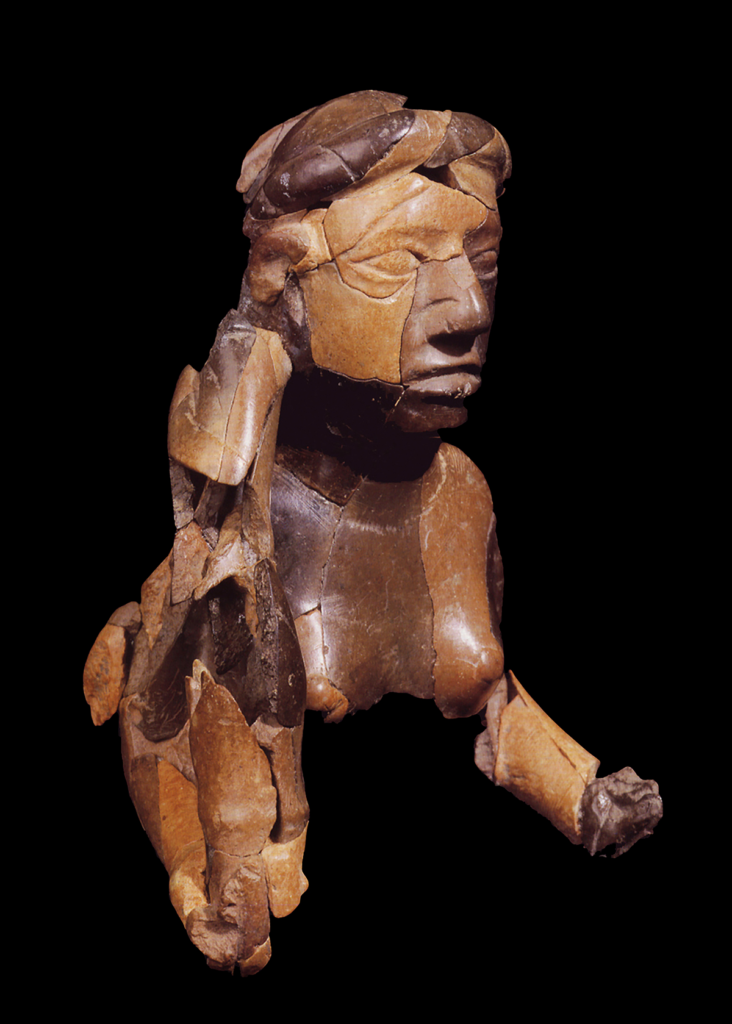Cahokia was a city located east of St. Louis, Missouri, and made up of many large earthen mounds. This city was the largest pre-Columbus city north of Mexico and was a thriving community for around four centuries (Seppa,1997). There have been many speculations surrounding the possible religious aspects of Cahokians. It is difficult to determine the religious beliefs or practices of these people, as there was little time given to excavate and it has been demolished since then.

Many theories around Cahokian religion support the notion that constellations played an important role in Cahokian religion. The practice of Cahokian descendants “observing religion based on earth and sky Gods including the Morning and Evening stars”(Pauketat, 2009, 20) was documented by French and Spanish colonizers. It is also believed that the mounds of Cahokia were made concerning celestial events, specifically the patterns of the moon and sun. This theory can be seen in Emerald, whose mounds are also linked to constellations, specifically the moon and its patterns, Emerald appears to be a smaller version of Cahokia connected by a road (Ahmad, 2023). Emerald is thought to be more of a religious destination than the bustling community of Cahokia. The mounds of Emerald are thought to have been built for religious reasons. “Over the past four years, excavations at Emerald have uncovered two dozen half-buried structures with burned materials in their hearths and a striking yellow plaster on their floors. Alt believes these are “shrine houses” that people would visit as part of a personal spiritual practice”(Witze, 2016). These mounds are hypothesized to be in some ways an attempt to be closer to god or the spirits above. There have been many remnants of burnt structures that are thought to have religious meaning, this has been documented in both Cahokia and Emerald. Although it is believed that Emerald held most of the religious ceremonies there is evidence that some of Cahokia’s mounds were religion-based too. Sculptures of Goddesses and powerful animals have been found in Cahokia, emphasizing the religious practices of Cahokians. During the excavation of Mound 34 at Cahokia, the archeologists found lots of buried shark teeth, beads, and arrow points. During a later excavation, they realized there had been a building atop this mound that had been burnt down and these charred remnants were dropped on the terrace below likely with religious intention (Witze, 2016). “They argue that Cahokians may have conducted a series of rituals at the mound, perhaps enlarging it in an effort to bring earthly activities closer to the sky above”(Witze, 2016). Although it is difficult to pin down precisely what the Cahokians believed or what their religious values were it seems clear that religion played an important role in Cahokian’s lives.

Future Research:
https://www.nps.gov/articles/000/cahokia-mounds-state-historic-site-world-heritage-site.htm
References:
Ahmad, Fazal. “Places of Worship – Cahokia Mounds.” The Review of Religions, 29 Aug. 2023, www.reviewofreligions.org/42797/places-of-worship-cahokia-mounds/.
Anwar, Yasmin. “New Study Debunks Myth of Cahokia’s Native American Lost Civilization.” Berkeley, news.berkeley.edu/2020/01/27/new-study-debunks-myth-of-cahokias-native-american-lost-civilization. Accessed 5 Nov. 2023.
Bowdoin, Susan. “Religion and the Rise of Cahokia.” The Archaeological Conservancy, 12 Mar. 2016, www.archaeologicalconservancy.org/religion-and-the-rise-of-cahokia/.
Pauketat, Timothy. “Ancient American Goddesses on Display.” ILLINOIS, 2 Feb. 2018, news.illinois.edu/view/6367/607716.
Pauketat, Timothy R. Cahokia: Ancient America’s Great City on the Mississippi. Penguin Books, 2010.
Seppa, Nathan. “Metropolitan Life on the Mississippi.” The Washington Post, WP Company, www.washingtonpost.com/wp-srv/national/daily/march/12/cahokia.htm. Accessed 5 Nov. 2023.
Witze, Alexandra. “Religion and the Rise of Cahokia.” Issuu, from American Archaeology Magazine | Spring 2016 | Vol. 20 No. 1by American Archaeology Magazine, 27 July 2021, issuu.com/americanarchaeologymagazine/docs/aam-spr-2016/s/12948966#:~:text=Religion%20was%20not%20just%20a,one%20of%20Cahokia’s%20smaller%20mounds.

“Although it is difficult to pin down precisely what the Cahokians believed or what their religious values were it seems clear that religion played an important role in Cahokian’s lives.” — What challenges were faced by archaeologists as they attempted to pinpoint the role of religion in Cahokia? What might be some possible solutions to resolving these issues?
A major challenge for the Archaeologists studying Cahokia, was the time constraints. It was difficult to determine the details of religious beliefs and processes of Cahokia as the process was forced to be rushed and there is much which was demolished. There is also no written documents from the time of Cahokia, which would have helped explain details of Cahokia. If there was more prioritization of archaeological discoveries, and appreciation for the importance of archaeological excavation then it would be easier to more carefully and slowly uncover parts of Cahokia which could lead to a greater understanding of their religion.